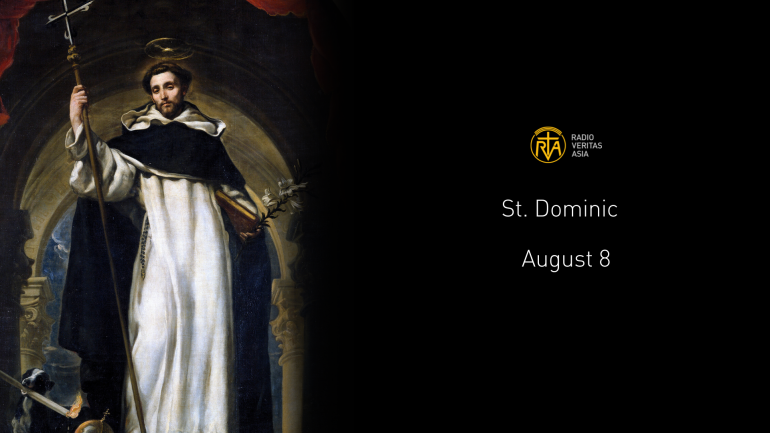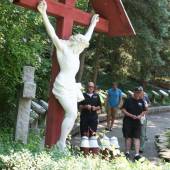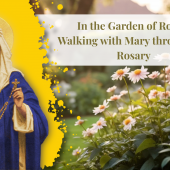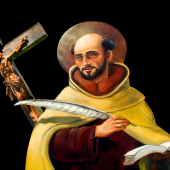Did Dominic Really Receive the Rosary from Our Lady — or Is the Story More Complex?

For hundreds of years, Catholics have pictured St. Dominic kneeling in prayer while the Blessed Virgin Mary gives him a string of beads, which we now call the Rosary.
This popular image has become central to Dominican spirituality and Marian devotion. But like many stories passed down through time, the real story is more complex and profound than we might think.
According to Dominican tradition, the Virgin Mary appeared to St. Dominic in 1208 at the church of Prouille and gave him the Rosary. However, historians have long debated whether this event happened exactly as described. Some scholars, especially in the 17th century, pointed out the lack of historical evidence for a literal apparition.
Still, the story remains deeply woven into Dominican spirituality and the Catholic understanding of the Rosary’s power. Whether or not Mary physically handed Dominic the Rosary, what matters is that through his preaching, devotion, and inspiration from Our Lady, this prayer became a lifeline for countless souls.
Devotion to the Rosary and preaching characterized the life of St. Dominic de Guzman, founder of the Order of Preachers, also known as the Dominicans.
Dominic was born in 1170 in Caleruega, Spain, into a noble and devout family. Even as a child, he showed signs of extraordinary compassion and spiritual depth. One story tells how, during a famine, he sold his cherished collection of books to buy food for the poor, long before he ever stood in a pulpit or wore a religious habit.
He studied theology at the University of Palencia, but it was during a journey with his bishop that Dominic had a life-changing encounter. While traveling through southern France, he came face-to-face with the Albigensian heresy, a widespread belief that rejected the goodness of the material world. Dominic was deeply moved by how people had strayed from the truth, and even more by how few were speaking to their hearts with love and clarity.
Instead of turning away, Dominic stepped forward with a new vision. He believed that preaching should be rooted in study, humility, and holiness. In 1216, he received papal approval to found a new religious order: the Order of Preachers.
With a deep commitment to both truth and compassion, Dominic’s followers were trained in theology and philosophy. They were expected to live simply, pray deeply, and engage the world with mercy.
Dominic himself traveled tirelessly, preaching in the streets, debating heretics, and building communities that would last long after his death. He never sought popularity, only to bring people back to Christ.
In times of spiritual struggle, Dominic turned to prayer. According to some accounts, it was during these moments that the Blessed Virgin Mary appeared to him, encouraging a meditative form of prayer centered on the lives of Jesus and Mary.
While it’s true that the Rosary as we pray it today was developed over time, especially by the Dominicans in the 15th century, St. Dominic’s role in its spread remains essential. His preaching often involved encouraging people to meditate on Christ's life through structured, repetitive prayer.
This is why, even today, the image of Dominic receiving the Rosary stands not as a historical photograph but as a spiritual truth.
St. Dominic died in 1221, but his legacy spread far and wide. His followers, the missionary Dominicans, brought the faith to the corners of the world, including Asia.
In the Philippines, devotion to St. Dominic remains particularly strong. The Santo Domingo Church in Quezon City, home to Our Lady of the Holy Rosary La Naval de Manila, is a major center of Dominican presence and Marian devotion. The church is not only the largest in Metro Manila but also one of the most vibrant symbols of Dominican mission in Asia.
Each year, thousands of devotees join the La Naval procession, celebrating not only Our Lady but also honoring the Dominican tradition she helped shape, beginning with Dominic himself.
Dominican schools, colleges, and seminaries across Asia continue to form young minds and hearts in the pursuit of truth, guided by Dominic’s charism: to contemplate and to share the fruits of contemplation. In the Philippines, this mission is especially visible through the University of Santo Tomas, the oldest existing university in Asia and a pontifical institution under Dominican leadership. For centuries, it has stood as a pillar of Catholic education in the region.
In today’s world, overwhelmed by noise and confusion, St. Dominic offers a different path. He invites us to listen more deeply, to study not just for knowledge but for love, and to preach not with pride but with compassion.
Whether or not Our Lady physically handed him the Rosary, what matters is that he propagated the devotion with inspiration. He taught the world to pray, to think, and to speak with faith and courage.
Today, across Asia and beyond, he remains a gentle yet powerful reminder that truth, when spoken with love, can still change hearts.
Radio Veritas Asia (RVA), a media platform of the Catholic Church, aims to share Christ. RVA started in 1969 as a continental Catholic radio station to serve Asian countries in their respective local language, thus earning the tag “the Voice of Asian Christianity.” Responding to the emerging context, RVA embraced media platforms to connect with the global Asian audience via its 21 language websites and various social media platforms.














